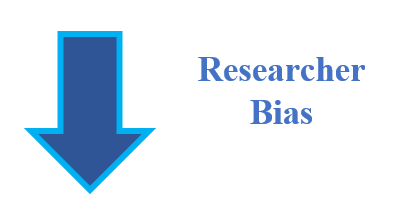20.1 Introduction to qualitative rigor
We hear a lot about fake news these days. Fake news has to do with the quality of journalism that we are consuming. It begs questions like: does it contain misinformation, is it skewed or biased in its portrayal of stories, does it leave out certain facts while inflating others. If we take this news at face value, our opinions and actions may be intentionally manipulated by poor quality information. So, how do we avoid or challenge this? The oversimplified answer is, we find ways to check for quality. While this isn’t a chapter dedicated to fake news, it does offer an important comparison for the focus of this chapter, rigor in qualitative research. Rigor is concerned with the quality of research that we are designing and consuming. While I devote a considerable amount of time in my clinical class talking about the importance of adopting a non-judgmental stance in practice, that is not the case here; I want you to be judgmental, critical thinkers about research! As a social worker who will hopefully be producing research (we need you!) and definitely consuming research, you need to be able to differentiate good science from rubbish science. Rigor will help you to do this.

This chapter will introduce you to the concept of rigor and specifically, what it looks like in qualitative research. We will begin by considering how rigor relates to issues of ethics and how thoughtfully involving community partners in our research can add additional dimensions in planning for rigor. Next, we will look at rigor in how we capture and manage qualitative data, essentially helping to ensure that we have quality raw data to work with for our study. Finally, we will devote time to discussing how researchers, as human instruments, need to maintain accountability throughout the research process. Finally, we will examine tools that encourage this accountability and how they can be integrated into your research design. Our hope is that by the end of this chapter, you will begin to be able to identify some of the hallmarks of quality in qualitative research, and if you are designing a qualitative research proposal, that you consider how to build these into your design.
19.1 Introduction to qualitative rigor
Learning Objectives
Learners will be able to…
- Identify the role of rigor in qualitative research and important concepts related to qualitative rigor
- Discuss why rigor is an important consideration when conducting, critiquing and consuming qualitative research
- Differentiate between quality in quantitative and qualitative research studies
In Chapter 11 we talked about quality in quantitative studies, but we built our discussion around concepts like reliability and validity. With qualitative studies, we generally think about quality in terms of the concept of rigor. The difference between quality in quantitative research and qualitative research extends beyond the type of data (numbers vs. words/sounds/images). If you sneak a peek all the way back to Chapter 7, we discussed the idea of different paradigms or fundamental frameworks for how we can think about the world. These frameworks value different kinds of knowledge, arrive at knowledge in different ways, and evaluate the quality of knowledge with different criteria. These differences are essential in differentiating qualitative and quantitative work.
Quantitative research generally falls under a positivist paradigm, seeking to uncover knowledge that holds true across larger groups of people. To accomplish this, we need to have tools like reliability and validity to help produce internally consistent and externally generalizable findings (i.e. was our study design dependable and do our findings hold true across our population).
In contrast, qualitative research is generally considered to fall into an alternative paradigm (other than positivist), such as the interpretive paradigm which is focused on the subjective experiences of individuals and their unique perspectives. To accomplish this, we are often asking participants to expand on their ideas and interpretations. A positivist tradition requires the information collected to be very focused and discretely defined (i.e. closed questions with prescribed categories). With qualitative studies, we need to look across unique experiences reflected in the data and determine how these experiences develop a richer understanding of the phenomenon we are studying, often across numerous perspectives.
Rigor is a concept that reflects the quality of the process used in capturing, managing, and analyzing our data as we develop this rich understanding. Rigor helps to establish standards through which qualitative research is critiqued and judged, both by the scientific community and by the practitioner community.

For the scientific community, people who review qualitative research studies submitted for publication in scientific journals or for presentations at conferences will specifically look for indications of rigor, such as the tools we will discuss in this chapter. This confirms for them that the researcher(s) put safeguards in place to ensure that the research took place systematically and that consumers can be relatively confident that the findings are not fabricated and can be directly connected back to the primary sources of data that was gathered or the secondary data that was analyzed.
As a note here, as we are critiquing the research of others or developing our own studies, we also need to recognize the limitations of rigor. No research design is flawless and every researcher faces limitations and constraints. We aren’t looking for a researcher to adopt every tool we discuss below in their design. In fact, one of my mentors, speaks explicitly about “misplaced rigor”, that is, using techniques to support rigor that don’t really fit what you are trying to accomplish with your research design. Suffice it to say that we can go overboard in the area of rigor and it might not serve our study’s best interest. As a consumer or evaluator of research, you want to look for steps being taken to reflect quality and transparency throughout the research process, but they should fit within the overall framework of the study and what it is trying to accomplish.
From the perspective of a practitioner, we also need to be acutely concerned with the quality of research. Social work has made a commitment, outlined in our Code of Ethics (NASW,2017), to competent practice in service to our clients based on “empirically based knowledge” (subsection 4.01). When I think about my own care providers, I want them to be using “good” research—research that we can be confident was conducted in a credible way and whose findings are honestly and clearly represented. Don’t our clients deserve the same from us?

As providers, we will be looking to qualitative research studies to provide us with information that helps us better understand our clients, their experiences, and the problems they encounter. As such, we need to look for research that accurately represents:
- Who is participating in the study
- What circumstances is the study being conducted under
- What is the research attempting to determine
Further, we want to ensure that:
- Findings are presented accurately and reflect what was shared by participants (raw data)
- A reasonably good explanation of how the researcher got from the raw data to their findings is presented
- The researcher adequately considered and accounted for their potential influence on the research process
As we talk about different tools we can use to help establish qualitative rigor, I will try to point out tips for what to look for as you are reading qualitative studies that can reflect these. While rigor can’t “prove” quality, it can demonstrate steps that are taken that reflect thoughtfulness and attention on the part of the researcher(s). This is a link from the American Psychological Association on the topic of reviewing qualitative research manuscripts. It’s a bit beyond the level of critiquing that I would expect from a beginning qualitative research student, however, it does provide a really nice overview of this process. Even if you aren’t familiar with all the terms, I think it can be helpful in giving an overview of the general thought process that should be taking place.
To begin breaking down how to think about rigor, I find it helpful to have a framework to help understand different concepts that support or are associated with rigor. Lincoln and Guba (1985) have suggested such a framework for thinking about qualitative rigor that has widely contributed to standards that are often employed for qualitative projects. The overarching concept around which this framework is centered is trustworthiness. Trustworthiness is reflective of how much stock we should put in a given qualitative study—is it really worth our time, headspace, and intellectual curiosity? A study that isn’t trustworthy suggests poor quality resulting from inadequate forethought, planning, and attention to detail in how the study was carried out. This suggests that we should have little confidence in the findings of a study that is not trustworthy.
According to Lincoln and Guba (1985)[1] trustworthiness is grounded in responding to four key ideas and related questions to help you conceptualize how they relate to your study. Each of these concepts is discussed below with some considerations to help you to compare and contrast these ideas with more positivist or quantitative constructs of research quality.
Truth value
You have already been introduced to the concept of internal validity. As a reminder, establishing internal validity is a way to ensure that the change we observe in the dependent variable is the result of the variation in our independent variable—did we actually design a study that is truly testing our hypothesis. In much/most qualitative studies we don’t have hypotheses, independent or dependent variables, but we do still want to design a study where our audience (and ourselves) can be relatively sure that we as the researcher arrived at our findings through a systematic and scientific process, and that those findings can be clearly linked back to the data we used and not some fabrication or falsification of that data; in other words, the truth value of the research process and its findings. We want to give our readers confidence that we didn’t just make up our findings or “see what we wanted to see”.

Applicability
- who we were studying
- how we went about studying them
- what we found

Consistency

Neutrality

These concepts reflect a set of standards that help to determine the integrity of qualitative studies. At the end of this chapter you will be introduced to a range of tools to help support or reflect these various standards in qualitative research. Because different qualitative designs (e.g. phenomenology, narrative, ethnographic), that you will learn more about in Chapter 22 emphasize or prioritize different aspects of quality, certain tools will be more appropriate for these designs. Since this chapter is intended to give you a general overview of rigor in qualitative studies, exploring additional resources will be necessary to best understand which of these concepts are prioritized in each type of design and which tools best support them.
Key Takeaways
- Qualitative research is generally conducted within an interpretativist paradigm. This differs from the post-positivist paradigm in which most quantitative research originates. This fundamental difference means that the overarching aim of these different approaches to knowledge building differ, and consequently, our standards for judging the quality of research within these paradigms differ.
- Assessing the quality of qualitative research is important, both from a researcher and a practitioner perspective. On behalf of our clients and our profession, we are called to be critical consumers of research. To accomplish this, we need strategies for assessing the scientific rigor with which research is conducted.
- Trustworthiness and associated concepts, including credibility, transferablity, dependability and confirmability, provide a framework for assessing rigor or quality in qualitative research.
- Lincoln, Y. S., & Guba, E. G. (1985). Naturalistic inquiry. Newberry Park, CA: Sage ↵
Rigor is the process through which we demonstrate, to the best of our ability, that our research is empirically sound and reflects a scientific approach to knowledge building.
The degree to which an instrument reflects the true score rather than error. In statistical terms, reliability is the portion of observed variability in the sample that is accounted for by the true variability, not by error. Note: Reliability is necessary, but not sufficient, for measurement validity.
The extent to which the scores from a measure represent the variable they are intended to.
a paradigm guided by the principles of objectivity, knowability, and deductive logic
Findings form a research study that apply to larger group of people (beyond the sample). Producing generalizable findings requires starting with a representative sample.
a paradigm based on the idea that social context and interaction frame our realities
in a literature review, a source that describes primary data collected and analyzed by the author, rather than only reviewing what other researchers have found
Data someone else has collected that you have permission to use in your research.
unprocessed data that researchers can analyze using quantitative and qualitative methods (e.g., responses to a survey or interview transcripts)
Trustworthiness is a quality reflected by qualitative research that is conducted in a credible way; a way that should produce confidence in its findings.
Ability to say that one variable "causes" something to happen to another variable. Very important to assess when thinking about studies that examine causation such as experimental or quasi-experimental designs.
The level of confidence that research is obtained through a systematic and scientific process and that findings can be clearly connected to the data they are based on (and not some fabrication or falsification of that data).
The ability to apply research findings beyond the study sample to some broader population,
This is a synonymous term for generalizability - the ability to apply the findings of a study beyond the sample to a broader population.
The potential for qualitative research findings to be applicable to other situations or with other people outside of the research study itself.
Consistency is the idea that we use a systematic (and potentially repeatable) process when conducting our research.
a single truth, observed without bias, that is universally applicable
one truth among many, bound within a social and cultural context
The idea that qualitative researchers attempt to limit or at the very least account for their own biases, motivations, interests and opinions during the research process.
